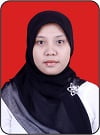The Identification of the Students’ Mathematical Communication Skills Error in Form of Pictures on the Geometry of Space Subject
Abstract
ABSTRACT: The space geometry is one of the major subjects, which must be taken by the students of the mathematics education. The aim of the courses is to make students are able to master the form geometry in three dimensions. Competencies must be mastered include the ability to draw space, the ability to draw the slice field, and the ability to determine the extents of the slice field. Based on the competencies, the material of the space geometry was not an easy matter to be mastered by students. Students needed their imagination to visualize the shape, which came from the two-dimensional images shaped into a three dimensional or vice versa. These difficulties did not only occur on the students, but also the mathematics teachers, who had the learning process in the schools. This research belonged to qualitative descriptive study, in which the subject of this research was the class A second semester students of Mathematics Education Study Program of UMP (Muhammadiyah University of Purwokerto) in Central Java, Indonesia, in academic year 2015/2016, which belonged to the class of the shape geometry. The instruments which were used were the observation sheet and the documentation in the form of photographs or videos. The research procedures consisted of the steps in the lesson study in 3 cycles. Each cycle consisted of plan, do, and see steps. The result of the study was that the students’ error of mathematical communication ability was in the form of pictures on the space geometry subjects occurred on the drawing procedure in the determination of the slice field; the concept of an image in three dimensions; and the students’ concept in the fields analysis.
KEY WORDS: Mathematical Communication Skill; Lesson Study; Geometry of Space; Form of Pictures; Students’ Concept.


About the Authors: Anggun Badu Kusuma and Reni Untarti are the Lecturers at the Departement of Mathematics Education, Faculty of Education and Teacher Training UMP (Muhammadiyah University of Purwokerto), Jalan Raya Dukuhwaluh, Purwokerto City, Central Java, Indonesia. E-mails: anggunbadu@ump.ac.id and reniuntarti@gmail.com
Suggested Citation: Kusuma, Anggun Badu & Reni Untarti. (2018). “The Identification of the Students’ Mathematical Communication Skills Error in Form of Pictures on the Geometry of Space Subject” in EDUCARE: International Journal for Educational Studies, Volume 10(2), February, pp.87-94. Bandung, Indonesia and BS Begawan, Brunei Darussalam: Minda Masagi Press owned by ASPENSI and BRIMAN Institute, ISSN 1979-7877.
Article Timeline: Accepted (December 13, 2017); Revised (January 15, 2018); and Published (February 28, 2018).
Keywords
Full Text:
PDFReferences
Attride-Stirling, J. (2001). “Thematic Networks: An Analytic Tool for Qualitative Research” in Qualitative Research, Vol.1, No.3, pp.385-405. Available online also at: http://goo.gl/VpQeQJ [accessed in Purwokerto, Indonesia: October 28, 2016].
Barmby, Patrick et al. (2013). Developing the Use of Visual Representations in the Primary Classroom. UK [United Kingdom]: Durham University. Available online also at: http://www.nuffieldfoundation.org/sites/default/files/files/Developing [accessed in Purwokerto, Indonesia: October 28, 2016].
Bold, Christine Elizabeth. (2001). “Making Sense of Mathematical Language in a Primary Classroom”. Unpublished Doctoral Dissertation. Available online also at: https://oro.open.ac.uk/18838/1/pdf133.pdf [accessed in Purwokerto, Indonesia: September 12, 2016].
Budiarto, Mega T., Koespono & T.R. Nindyo. (1998). “Analisis Kesalahan Materi Geometri bagi Guru-guru SLTP dan SMA”. Unpublished Research Result. Surabaya: Pusat Penelitian IKIP [Institut Keguruan dan Ilmu Pendidikan] Surabaya.
Chun, Youngsub. (2015). “How to Communicate with Others: The Effective Communication Skills”. Available online at: https://www.linkedin.com/pulse/how-communicate [accessed in Purwokerto, Indonesia: September 12, 2016].
Creswell, J.W. (1998). Qualitative Inquiry and Research Design: Choosing among Five Traditions. Thousand Oaks, CA: Sage.
Dansereau, F. & S.E. Markham. (1987). “Superior-Subordinate Communication: Multiple Levels of Analysis” in F.M. Jablin et al. [eds]. Handbook of Organizational Communication. Newbury Park, CA: Sage, pp.343-388.
Elliott, Robert & Ladislav Timulak. (2005). “Descriptive and Interpretive Approaches to Qualitative Research”. Available online at: http://nideffer.net/classes/GCT_RPI_S14/readings/interpretive.pdf [accessed in Purwokerto, Indonesia: September 12, 2016].
Eryaman, Zeynep. (2009). “A Study on Sixth Grade Students’ Spatial Reasoning Regarding 2D Representations of 3D Objects”. Unpublished Master Thesis. Available online also at: https://etd.lib.metu.edu.tr/upload/3/12611378/index.pdf [accessed in Purwokerto, Indonesia: September 12, 2016].
Evbuomwan, Dickson. (2013). “An Investigation into the Difficulties Faced by Form C Students in the Learning of Transformation Geometry in Lesotho Secondary Schools”. Unpublished Master Thesis. South Africa: University of South Africa. Available online also at: http://uir.unisa.ac.za/bitstream/handle/10500/10589/dissertation_evbuowan [accessed in Purwokerto, Indonesia: October 28, 2016].
Flevares, Lucia M. & Jamie R. Schiff. (2014). “Learning Mathematics in Two Dimensions: A Review and Look Ahead at Teaching and Learning Early Childhood Mathematics with Children’s Literature” in Frontiers in Psychology, Volume 5. Available online also at: https://www.ncbi.nlm.nih.gov/pmc/articles/PMC4033191/ [accessed in Purwokerto, Indonesia: October 28, 2016].
Jacobs, G.M., G.S. Lee & J. Ball. (1996). Learning Cooperative Learning via Cooperative Learning: A Sourcebook of Lesson Plans for Teacher Education on Cooperative Learning. Singapore: SEAMEO Regional Language Center.
Kariadinata, R. (2010). “Kemampuan Visualisasi Geometri Spasial Siswa Madrasah Aliyah Negeri (MAN) Kelas X melalui Software Pembelajaran Mandiri” in Jurnal EDUMAT, Vol.1(2).
Kawulich, Barbara B. (2005). “Participant Observation as a Data Collection Method” in FQSR: Forum Qualitative Social Research, Vol.6(2). Available online also at: http://www.qualitative-research.net/index.php/fqs/article/view/466/996 [accessed in Purwokerto, Indonesia: September 12, 2016].
Kemendiknas RI [Kementerian Pendidikan Nasional Republik Indonesia] et al. (2012). Panduan untuk Lesson Study Berbasis MGMP dan Lesson Study Berbasis Sekolah. Jakarta: Penerbit IDC.
Kilpatrick, J., C. Hoyles & O. Skovsmose. (2005). Meaning in Mathematics Education. New York: Springer.
Lee, Ji-Eun & Mary Zeppelin. (2014). “Using Drawings to Bridge the Transition from Student to Future Teacher of Mathematics” in IEJEE: International Electronic Journal of Elementary Education, Vol.6(2), pp.333-346. Available online also at: https://files.eric.ed.gov/fulltext/EJ1053765.pdf [accessed in Purwokerto, Indonesia: September 12, 2016].
Morgan, C. (2002). Writing Mathematically: The Discourse of Investigation. Bristol: Taylor & Francis, Inc.
NCTM [National Council of Teachers of Mathematics]. (2000). Principles and Standarts for School Mathematics. Reston VA: The National Council of Teachers of Mathematics, Inc.
Newton, Ewart. (2015). “How Can Teachers Help Students Overcome Their Fear of Maths?”. Available online at: https://www.britishcouncil.org/voices-magazine/how-can-teachers-help-students [accessed in Purwokerto, Indonesia: October 28, 2016].
Paulu, Nancy. (2001). Helping Your Students with Homework: A Guide for Teachers. USA [United States of America]: Office of Educational Research and Improvement, U.S. Department of Education. Available online also at: https://www2.ed.gov/PDFDocs/hyc.pdf [accessed in Purwokerto, Indonesia: October 28, 2016].
Pope, C., S. Ziebland & N. Mays. (2000). “Analysing Qualitative Data” in British Medical Journal, 320, pp.114–116. Available online also at: http://www.ncbi.nlm.nih.gov/pmc/articles/PMC1117368/pdf/114.pdf [accessed in Purwokerto, Indonesia: September 12, 2016].
Pressman, H. Mark. (1997). “Hume on Geometry and Infinite Divisibility in the Treatise” in Hume Studies, Vol.XXIII, No.2 [November], pp.227-244. Available online also at: http://www.humesociety.org/hs/issues/v23n2/pressman/pressman-v23n2.pdf [accessed in Purwokerto, Indonesia: September 12, 2016].
Reilly, Anthony J. (1998). “Three Approaches to Organizational Learning” in The Pfeiffer Library, Vol.16(2). Available online also at: http://home.snu.edu/~jsmith/library/body/v16.pdf [accessed in Purwokerto, Indonesia: September 12, 2016].
Sava, Deanna Iris. (2007). “Visual Perception Related to School”. Available online at: https://mt08000619.schoolwires.net/cms/lib/MT08000619/Centricity/Domain [accessed in Purwokerto, Indonesia: October 28, 2016].
Shadiq, F. (2009). Kemahiran Matematika. Yogyakarta: Depdiknas RI [Departemen Pendidikan Nasional Republik Indonesia].
Soekamto, T. et al. (1993). Prinsip Belajar dan Pembelajaran. Jakarta: Depdikbud RI [Departemen Pendidikan dan Kebudayaan Republik Indonesia].
Susilo, H. et al. (2009). Lesson Study Berbasis Sekolah Guru Konservatif Menuju Guru Inovatif. Malang: Bayumedia.
Syaban. (2006). “Menumbuh-Kembangkan Daya Matematis Siswa” in Journal Pendidikan dan Budaya. Available online also at: http://educare.efkipunla.net/inde 2.php?option=com_content&d_pdf=1 &id=62. [accessed in Purwokerto, Indonesia: September 12, 2016].
Syamsuri, I. & Ibrohim. (2009). Lesson Study. Malang: UM [Universitas Negeri Malang] Press.
TA [Tim Akademik]. (2016). Panduan Akademik Universitas Muhammadiyah Purwokerto. Purwokerto: Penerbit UMP [Universitas Muhammadiyah Purwokerto] Press.
Van de Walle, J.A. (2007). Elementary and Middle School Mathematics: Teaching Developmentlly. Boston: Pearson Education, Inc., 6th edition.
Woodward, J. et al. (2012). Improving Mathematical Problem Solving in Grades 4 Through 8: A Practice Guide. Washington, DC: NCEE [National Center for Education Evaluation] and Regional Assistance, Institute of Education Sciences, U.S. Department of Education. Available online also at: http://ies.ed.gov/ncee/wwc/publications_reviews.aspx#pubsearch [accessed in Purwokerto, Indonesia: October 28, 2016].
EDUCARE: International Journal for Educational Studies. Ciptaan disebarluaskan di bawah Lisensi Creative Commons Atribusi-BerbagiSerupa 4.0 Internasional
